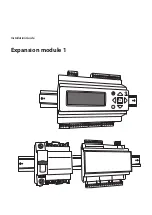
68
EN
Cod. 3542B230 - Rev. 00 - 02/2022
OMNIA S HYBRID H 3.2
11. COMMISSIONING
11.1 Heat pump commissioning
Before starting up for the first time, after a long pause, the following preliminary checks should be carried out on the electrical part and refrigeration part.
11.1.1 Preliminary heat pump checks
Refrigerating part
• Check that the unit is charged with refrigerant. The control can be carried out with portable freon pressure gauges fitted with a 1/4 “SAE revolving coupling with a
depressor connected to the tap service outlet. The pressure read must correspond to the saturation pressure corresponding to the ambient temperature (~ 7 bar) .
• Perform a visual check on the refrigeration circuit making sure it is not damaged.
• Check that there are no traces of oil on the pipes (they are found in line with refrigerant leakages from the cooling circuit).
HAZARD
Disconnect the power supply before carrying out any operation on the electrical panel of the unit.
After installing the indoor and outdoor units, check the following before powering them up:
• Wiring. Make sure that the electrical connections of the various parts of the system such as boiler, temperature probes, 2 and 3-way valves, pumps have been
carried out in accordance with the instructions in this manual, the wiring diagram supplied with the unit and in compliance with the laws and local regulations.
• Fuses, switches, or protection devices. Check that the fuses or protection devices installed locally are adequately sized based on the maximum current absorbed
by the unit as reported in this manual. Check that these protection devices are not bypassed.
• Grounding. Make sure that the earth wires have been connected correctly and that the earth terminals are tightened.
• Visually check the electrical panel to check for loose connections or damaged electrical components.
• Mounting. Check that the unit is mounted correctly to avoid abnormal noise and vibration when starting up the unit.
• Damaged components. Check the inside of the unit to check for damaged components or crushed pipes.
• Refrigerant leakage. Check the inside of the unit to check for refrigerant leaks. If there is a loss of refrigerant, contact the technical assistance service.
• Supply voltage. Check that the supply voltage to the unit corresponds to the power supply voltage indicated on the nameplate of the unit.
• Make sure the water shut-off valves are completely open
11.2 Commissioning the boiler
11.2.1 Boiler preliminary checks
• Check the tightness of the gas system.
• Check the correct pre-load of the expansion vessel.
• Fill the hydraulic system and vent all the air in the boiler and system.
• Make sure that there are not water leaks in the system, DHW circuits, connections or in the boiler.
• Make sure there are no flammable liquids or materials in the immediate vicinity of the boiler.
• Check the correct connection of the electrical system and the grounding function.
• Fill the siphon (see chap. 2.7).
HAZARD
IF THE ABOVE-MENTIONED INDICATIONS ARE NOT OBSERVED, THERE MAY BE A RISK OF SUFFOCATION OR
POISONING DUE TO GAS OR EXHAUST FUME LEAKS, RISK OF FIRE OR EXPLOSION. THERE MAY ALSO BE A RISK
OF ELECTRIC SHOCK OR FLOODING OF THE ROOM.
11.2.2 First boiler switch-on
• Make sure that there are no DHW withdrawals and requests from the room thermostat.
• Open the gas and check that the gas supply pressure valve upstream from the appliance complies with the one in the technical data table or, in any case, with
the tolerance laid down by the regulation.
• Power on the unit, the number of the software version of the control unit and display will appear.
• If the gas type is changed (G20 - G30 - G31 - G230), check if the relevant parameter is suitable for the type of gas present in the supply system (“Menu for
modifying the [TSP] parameters" on page 52).
• Check if the value of the flue parameter P68 - “Menu for modifying the [TSP] parameters" on page 52, is suitable for the length of flue installed.
• Switch the boiler to DHW or heating mode.
• In heating mode, make a request: the radiator symbol flashes on the display and the flame is displayed when the burner is lit.
• DHW mod with hot water withdrawal present: the tap symbol flashes on the display and the flame is displayed when the burner is lit.
• Run the combustion check as described in the paragraph “11.2.5 Checking the boiler combustion values" on page 69.
CAUTION
All the regulations described in this chapter can only be performed by qualified personnel.
















































